 USN Fleet Destroyers (1912-1935): USS Sampson, Rowan, Davis, Allen, Wilkes, Shaw (DD-63-68)
USN Fleet Destroyers (1912-1935): USS Sampson, Rowan, Davis, Allen, Wilkes, Shaw (DD-63-68)The Sampson-class destroyers were commissioned in 1916-1917, as the follow-up O’Brien/Tucker classes with 21-inch (533 mm) torpedo tubes, and last of the “1000-tonners”. Their main innovation was the introduction of four triple-mounts torpedo tubes, giving them a world-beating twelve-torpedo broadside, albeit halved due to their positions. Six ships were built, the last of a 26-ships serie started with the Paulding class. The largest and best of the serie they largely inspired a transitional class, the first “flush deck” Caldwell class, differing on many points.
The last “thousand-tonners”:
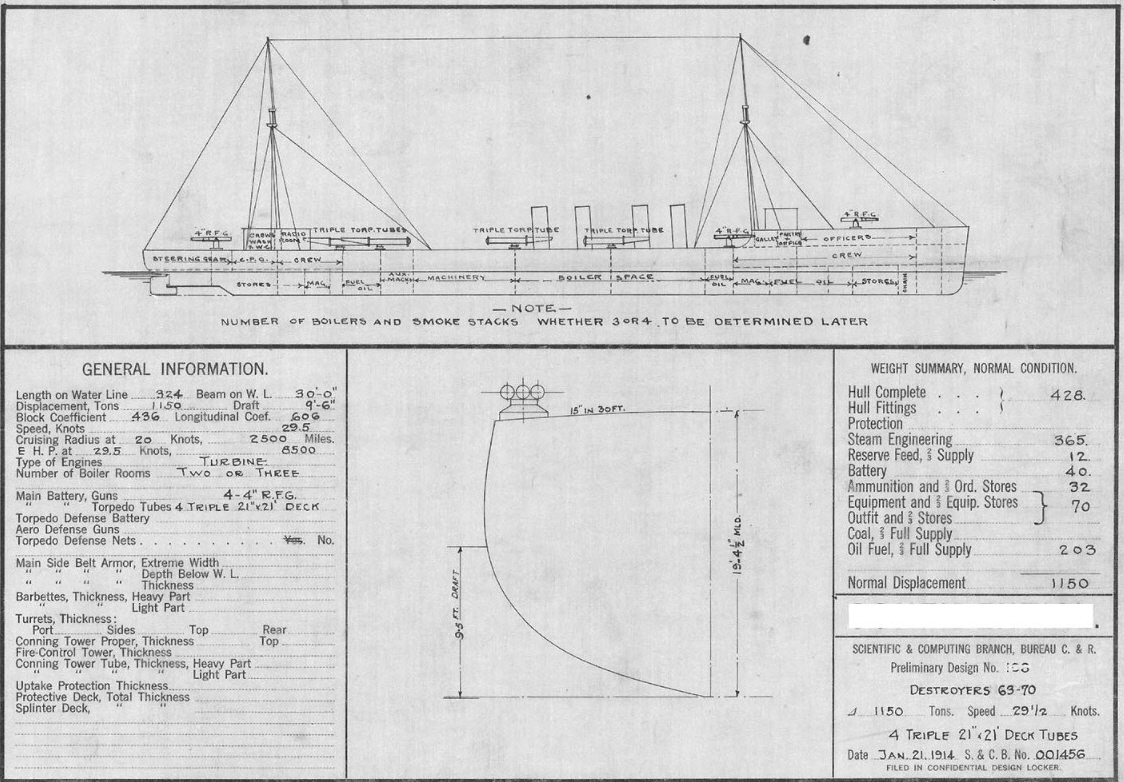
General Outlines, Sampson class
The Sampson class were thought at by the admiralty as another incremental step in design. The previous O’Brien/Tucker tried to improved both the armament by introducing 21-inches torpedo tubes, as well as range with different arrangement of turbines and boilers, with VTE and geared turbines for cruising and direct-drive for speed. For the last of these 26 ships in 1915, the Congress authorized six more ships (“torpedo boat destroyers Nos. 63–68”.
It seems on part the limits of the standard hull used from Paulding has been reached. Willing to improve again the speed, the range, and some arrangement for the armament, the admiralty board looked at more radical solutions. One way to see the problem was too look at the hull and see how to improve it, which was reserved for the next Caldwell. As for the DD-63 serie, they still were largely a reboot of the Tucker class with the ordnance proposed to study a triple torpedo tube banks instead of a twin one. Many calculations has to be made by the bureau of construction and repairs in order to have the deck strenghtened, stability rethought, etc. and not having these triple banks weighting too much, causing rolling.
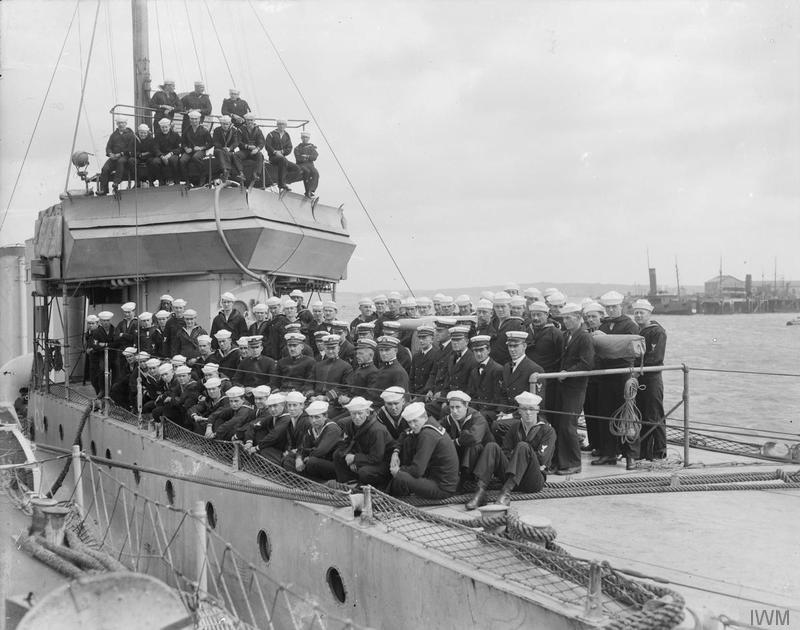
Crew of USS Sampson posing in 1917 – IWM
The gun armament remained the same except for these twelve 21 inch (533 mm) torpedo tubes. This was not only a significant increase over the Tucker class, but on all navies at the time as well.
For example the much larger contemporary Thornycroft type destroyer leader (1916) had only two triple 21 inch (533 mm) torpedo tubes on a 1,480 tons standard. So this was twice the armament on an almost 1/3 lighter tonnage !
Replacing four twin mounts with four triple mounts would in fact remain standard through the mass-production “flush-deck”, starting with thebtransitional Caldwell and all the mass-produced Wickes and Clemson classes commissioned through 1921. These banks however remained on the broadside, so only allpowing six-torpedo spreads. The General Board decision made over centerline torpedo tubes was to have still torpedoes remaining after firing a broadside by default of a reload. Experienced with centerline mounts was also a result of torpedoes striking gunwales. These were Mark 8 torpedo tubes.
The other armament innovation was the introduction of two single anti-aircraft 1-pdr (37 mm) autocannons. The Anti-submarine armament, depth charge rackes and Y-Gun, were added soon after completion for the 1917 ships as they were prepared for escort right away.
powerplant-wise, they still had the same main direct drive Curtis turbines and supplemented with geared cruising turbines either on one or two shafts.
Design of the class
Hull and general design
Same hull albeit longer and bit beamer compared to the Tuckers. The General design was a simple copy-paste of the previous ships. They basically had the very same hull, albeit enlarged further compared to the previous Tucker: 315 ft 3 in (96.09 m) in overall lenght for a beam of 30 ft 7 in (9.32 m) and draft of 10 ft 9 in (3.28 m), all increased figures. Compared to the initial Cassin class (305 ft 3 in x 30 ft 4 in x 9 ft 3 in (2.82 m)) shis shown that the beam was narrower, but the added lenght of ten feets improved seakeeping and speed, making for finer hull lines. The typical forecastle had some flare forward, an almost straight bow, a straight section whereas the waterline had none, having a long elliptic shape. The typical stern started rounded at deck level. The same rudder, porpeller struts was kept, with minor changes depending on the powerplant arrangement, but always two shafts.
The forecastle had recesses for the two amidships guns, despite the fact it was proven since the Cassins this arrangement was not the best in heavy weather, as the guns were not well protected from waterspray. The same general design was kept for the bridge, a simple enclosed wheelhouse with an open bridge on top, protected by canvas. Over time, the same beak-like rigid structure was added, and foldable windows while a tarpaulin was affixed semi-permanently on a frame above. Atop of it was a “3” shaped walkway. A platform was accomodated for the same froward projector at the end of it, but also the forward fire control rangefinder.
As for the rest of the deck it was roughly similar with four axial raked funnels, seven air vents intakes, same large deck hatch structure, aft quarterdeck/rado house aft, but its forward section was reshaped as she received her side projector mounted atop a lattice structure. The rest of the details remained the same apart an additional small service boat on davits starboard. The crew was the same, 99-110 of far less depending of the time (when used with the Coast Guard for example).
Powerplant
Virtual copy of the previous Tucker powerplant with two propellers, two shafts connected to Curtis steam direct drive turbines but followed by geared turbines working at lower pressure, mated on four Yarrow boilers for an average output of 17,696 hp (13,196 kW) and top speed of 29.5 kn (54.6 km/h; 33.9 mph). The main difference between them was on USS Allen, Wilkes and Shaw which only one a single shaft. It was on both on the three others.
Armament
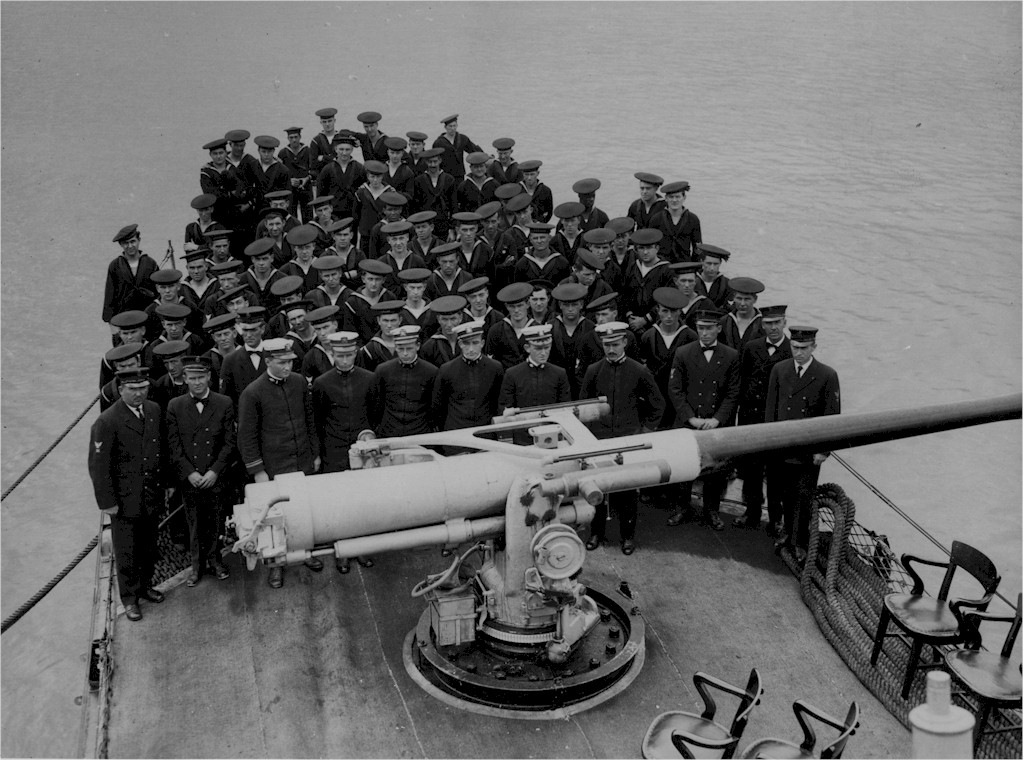
The crew of USS Allen posing behind the 4-in main gun.
Guns: 4x 4-in/50 Mark.
4-inch (102 mm)/50 Mark 9 guns weighing each more than 6,100 pounds (2,800 kg). They carried fired 33-pound (15 kg) armor-piercing (AP) shells exiting the barrel at 2,900 feet per second (880 m/s), reaching a target up to 15,920 yards (14,560 m) at 20° (max) elevation. They were placed the same way for all the thousand-tonners, in a lozenge pattern, one axial on the forcastle forward, two on deck level just abaft its break, and one axial aft on the weather deck. They were lef unshielded, apart canvas ones and rigid shields were installed in 1917 on the forecastle while canvas were installed for the admiships guns.
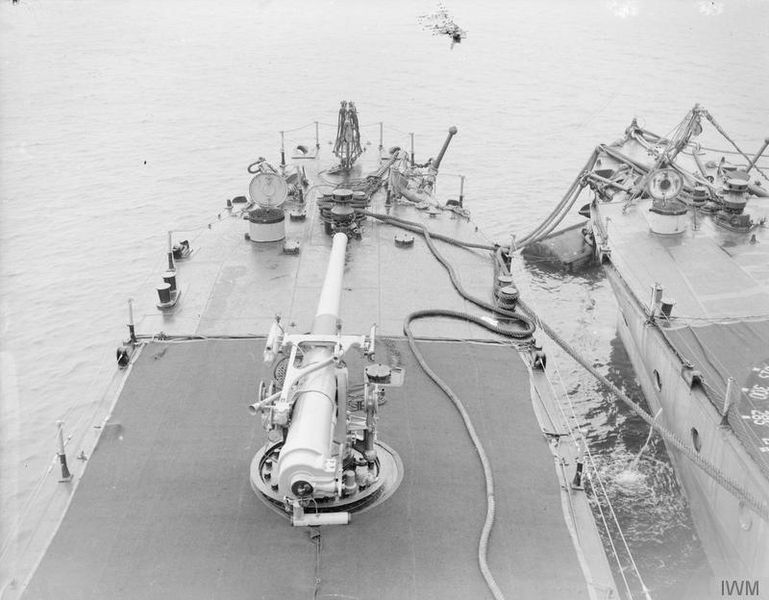
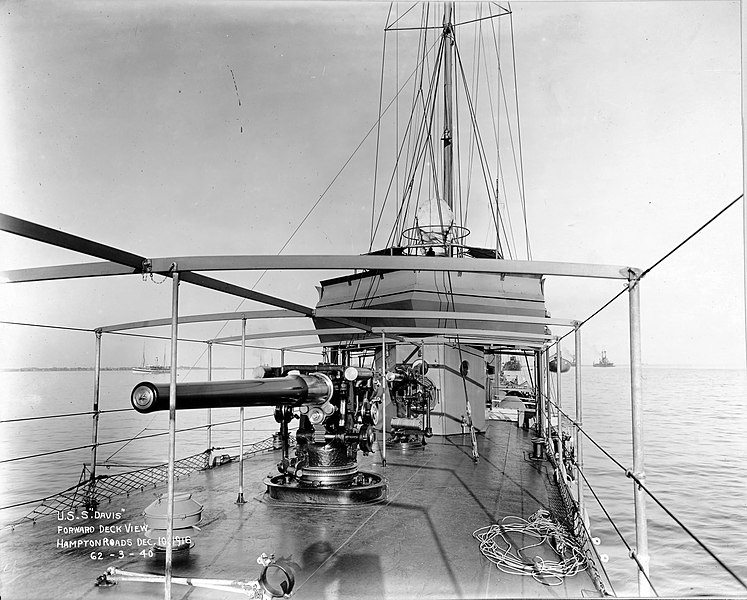
Looking aft from the bow of the USS Davis DD-65 toward the bridge area and forward guns.
Torpedoes: 4×3 21-in Mk. 8
These ships were given four triple Bliss-leavitt 21-inches Mark 8 Torpedo Tubes. They started to be introduced in the USN for destroyer use in 1915, so as they were ordered.
Characteristics:
Mods 0, 1, 2 or 2A: 2,761 lbs. (1,252 kg), 248 in (6.299 m) long, 321 lbs. (146 kg) TNT charge, settings 10,000 or 12,500 yards (9,140 or 11,430 m) at 27 knots. Powered by Wet-heater and guided by a Mark 8 Mod 1 gyro. The tube banks were staggered for better arcs of fire, located amidships and aft of the funnels, with the port ones closer to the bow. They faced forward and aft depending on their location but had very limited traverse inwards.
AA Guns: 2x 1-pdr
These autocannons were a derivative of the British 1-pdr QF “pompom”. The U.S. Navy adopted the Maxim-Nordenfelt 37 mm 1-pounder as the “Mark 6” before 1898. The Mark 7, 9, 14, and 15 followed and were adopted on US destroyers from the Sampson class onwards. These were the first dedicated anti-aircraft guns adopted by the US Navy, but later replaced by the more capable 3 inch (76 mm)/23.
They were located fore and aft, behind the forward main gun on the forecastle and superfiring on top pf the quartedeck hour aft.
Quickspecs: Automatic fire with recoil, ~300 rpm cyclic, belt-fed, mv 1,800 ft/s (550 m/s) range c4,000 yards.
In the 1930s they all received 1930s two Browning 12.7mm/90 hevay macihine guns for AA defence instead of their 1-pdrs.
Allen was further upgraded in 1940 (see later).
Profiles:
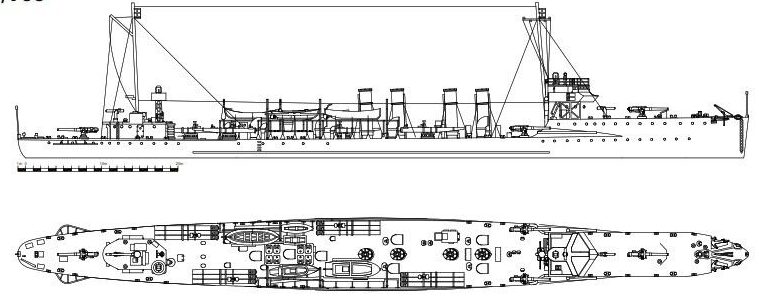
From Kombrig, probably 1918.
Others to come.
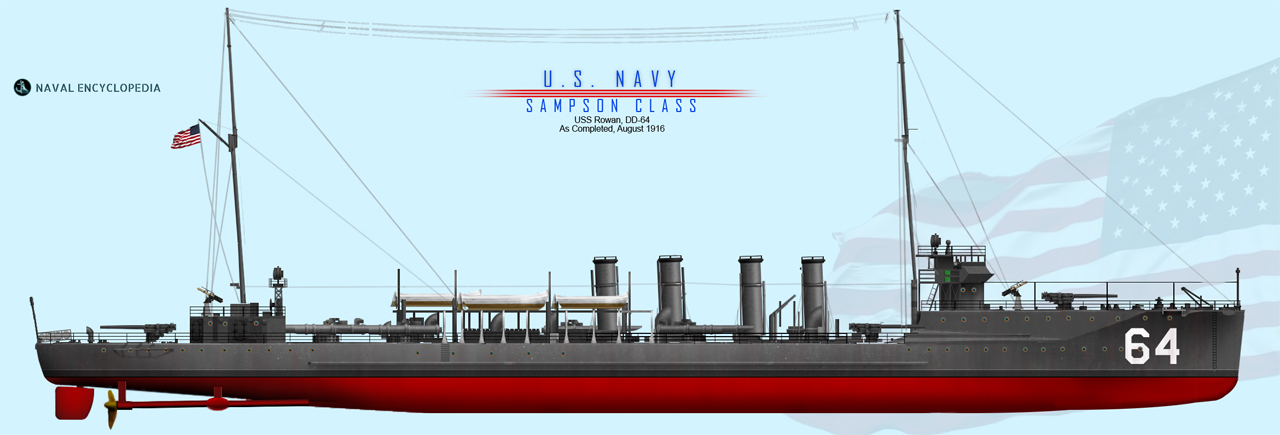
USS Rowan, DD-64, in August 1916 as completed.

USS Allen in 1918 (to come)
⚙ specifications |
|
| Displacement | 1,111 tons (normal) 1,225 tons (full load) |
| Dimensions | 315 ft 3 in x 30 ft 7 in x 10 ft 9 in (96.09 x 9.32 x 3.28 m) |
| Propulsion | 2 shafts Curtis DDS turbines (+1/2 GST ) 4 Yarrow boilers 17,696 hp (13,196 kW) |
| Speed | 29.5 kn (54.6 km/h; 33.9 mph) |
| Range | Circa 2500 nm/10 kts |
| Armament | 4× 4-in/50, 2× 1-pdr AA guns, 4×3 21 in (533 mm) TTs |
| Crew | 99 in 1916 |
The case of USS Allen: A “thousand tonner” in WW2

USS Allen in 1944 as modernized (to come)
Only ship in her class not scrapped to comply with the Washington treaty after some service in 1925, she was mothballed in Philadelphia but unlike the others not exhumed in 1934-39 to be scrapped. Instead she was recommissioned fully on 23 August 1940, modernized (she received notably a SC radar) and served with the Pacific Fleet as part of DesDiv 80. Present at Pearl Harbor during the attack she survived and was used for advanced training of submariners as defender, but she also patrolled between islands of the Hawaiian chain.
In 1946 when discarded she was the longest-serving destroyer on the Naval Vessel Register.
Modifications: In 1940, she underwent a serie of modifications: The two 1-pdr were removed, but she kept her four main guns, two aft TT banks removed, leaving only the forward ones. She received twelve depht-charge launchers placed where the former TTs previously resided, and two new depht-charge racks aft, plus a modern hull sonar.
She also had a new pole mainmast supporting an SC radar, boats and davits removed, partially rebuilt bridge, funnel cap on her forefunnel, no aft mastbut a small pole, new modern radio, new signal lamps, new direction finder and telemeter, projectors removed, and standard inflatable boats, and other structure modifications and additions.
In 1942 – 1943, she lost her two 12.7mm/90 AA and her two aft TT banks as her aft Y-gun but gained six 20mm/70 Mk 4 AA guns. The SC radar was replmaced by the SA and SE radars presumably. She was noted with an increased displacement to 1152/1433t.
Read More
Books
Friedman, Norman (2004). US Destroyers: An Illustrated Design History. NIP
Jane’s Fighting Ships of World War I. London: Random House Group, Ltd. 2001.
Silverstone, Paul H., U.S. Warships of World War I (Ian Allan, 1970)
Gardiner, Robert, Conway’s All the World’s Fighting Ships 1906-1921. Conway Maritime Press 1985.
Gardiner, Robert and Chesneau, Roger, Conway’s All the World’s Fighting Ships 1922-1946
Public domain Dictionary of American Naval Fighting Ships.
Links
on navypedia.org
More photos on commons.wikimedia.org
On destroyerhistory.org/
navweaps.com 4 in/50 mk9
navweaps.com ww1 US torpedoes
On history.navy.mil/
Model Kits

combrig-70676 sampson and wilkes 1916-1936 1:700 kit
iron-shipwrights uss-allen 1:350
3D
 USS Sampson DD-63
USS Sampson DD-63
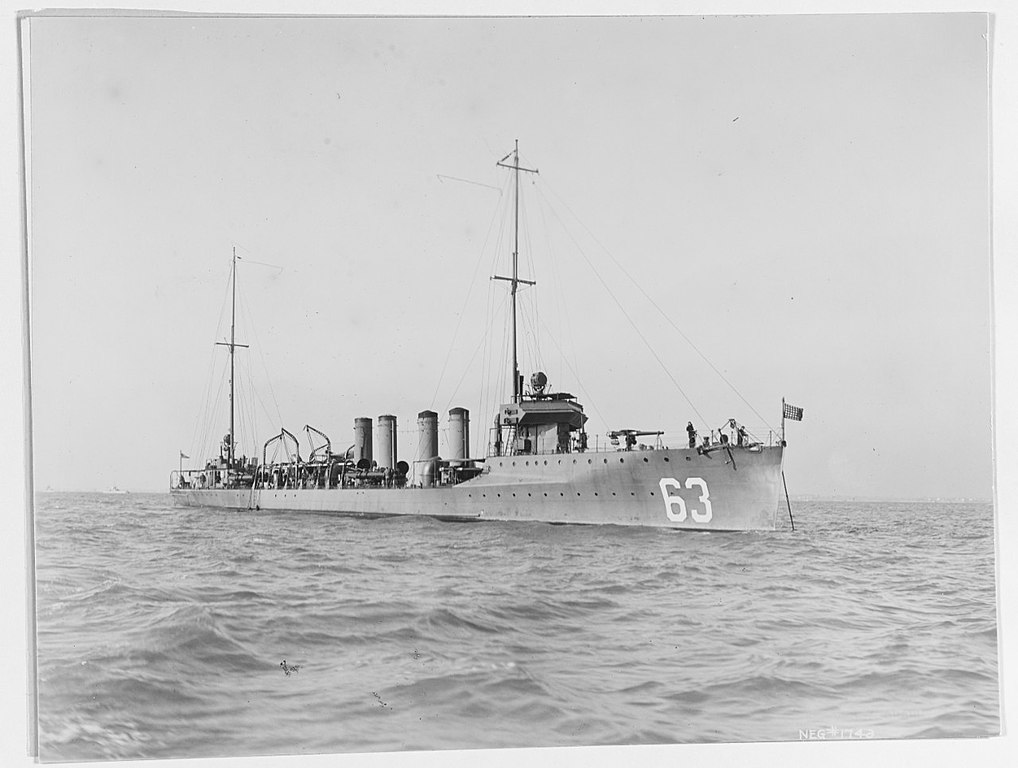
USS Sampson was assigned to Division 9 after commission and worjout, Atlantic Destroyer Force for her shakedown training cruiser in Narragansett Bay, Rhode Island, New York. From 6 April 1917, under command of Lt Cdr Mark L. Hersey, Jr. trained off Provincetown, Massachusetts and was prepared in Tompkinsville on 15 May 1917 to escort her first convoy which to Halifax. From there, she reached Queenstown in Ireland (25 May 1917). She was fitted with twi British-type depth charge projectors at the stern and commenced escort four days later. On 18 June 1917, she rescued survivors of the Monarch and Elele. Others will follow as well as several spottings and/or attacks but ni confirmed kill.
She moved to France after the war, escorted the liner SS George Washington into Brest and was back to Queenstown (14 December), departing for home, entering Brooklyn’s New York Navy Yard for upkeep and by 7 January 1919.
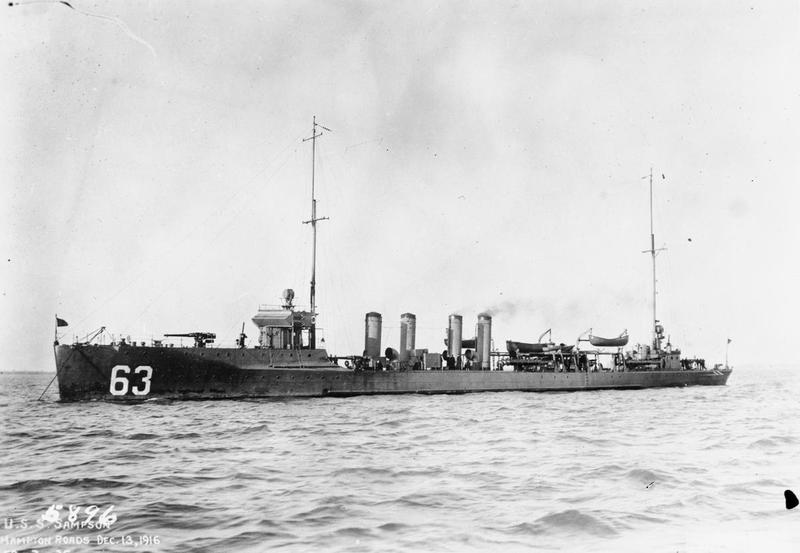
USS Sampson in Hampton Roads, December 1916
After this she was versed to the 4th Division, 2nd Flotilla Destroyer Force, departing on 22 March to the Naval Torpedo Station, Newport, Rhode Island for experimental testing of torpedoes and naval mines. By May she sailed to guard the route of NC-4 Atlantic crossing attempt. She ws deactivated from 1 December 1919 until 14 February 1921 in NY and decomm. in Philadelphia NyD in June.
She was stricken on 7 January 1936, sold on 8 September and scrapped in Baltimore.
 USS Rowan DD-64
USS Rowan DD-64
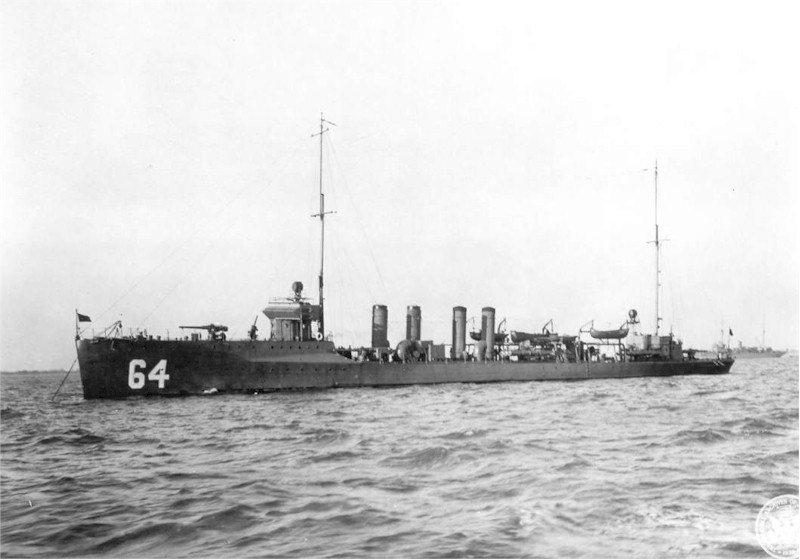
USS Rowan in 1916, in dark grey livery
USS Rowan was commissioned at Boston, Massachusetts on 22 August 1916 under command of Lt. William R. Purnell. After sea trials, shakedown in the Carribean, USS Rowan started destroyer force fleet exercises based from Newport in Rhode Island, working along the Atlantic coast in the fall of 1916, alternated with Carribean/Mexican waters winter exercises. She was in Norfolk, by April 1917, and patrolled off the mouth of the York River, before a short overhaul and upkeep in New York, prepared for war in Boston. On 7 May 1917 she departed Boston for Ireland, assigned to DesDiv 7 at Queenstown, starting operations in June.
Hr work alternated convoy escort in and out of British Isles waters and French ports like Brest, and antisubmarine patrols, with occasional rescues. On 28 May 1918 she took part in an U-boat hunt, dropping 14 depth charges and reporting an oil slick, and a “probable kill”.
She left Queenstown on 26 December 1918 for New Yorkn reached on 8 January 1919 and after an ovheraul, resumed exercises along the east coast and Caribbean, but on 29 August, she entered Philadelphia NyD to be placed in reduced commission.
In July 1920 she resumed operations and this went on until March 1922. She was decommissioned again in Philadelphia on 19 June 1922 and was inactive at League Island until stricken on 7 January 1936, sold for scrap on 20 April 1939.
 USS Davis DD-65
USS Davis DD-65
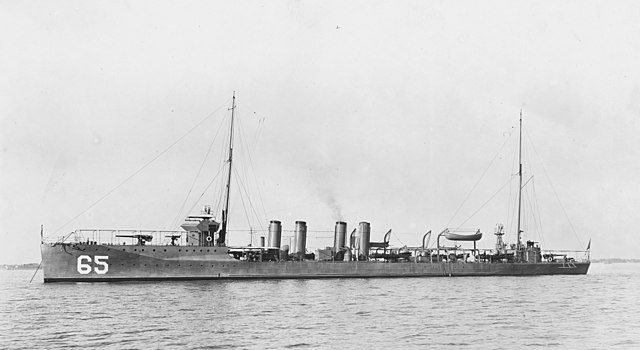
USS Davis was launched sponsored by Miss E. Davis, granddaughter of Admiral Davis (Civil war). She was commissioned 5 October 1916, went through sea trials and shakedown in the Carribean, and was soon assigned to Destroyer Force, Atlantic Fleet, in fleet training and neutrality patrols as her sisters, until 6 April 1917. She was prepared for overseas service while in Boston, and on the 24th, she departed with five other destroyers of the first detachment sent to Queenstown. She arrived on 4 May 1917 and started convoy escort and patrol duties. On 25-28 June 1917 notably the escorted the first American Expeditionary Force convoy to France.
On 24 February 1918, while in patrol with USS Paulding and USS Trippe off the south coast of Ireland she sighted the HMS L2’s periscope, and mistook it for a U-boat. She run at it and opened fire. L2 meanhile spotted them and submerged to 90 feet (27 m), and then 200 feet (61 m) whereas USS Paulding dropped two depth charges. One jammed L2’s diving planes and the unfortnunate sub eventually plunged straight down to the seabed under 300 feet (91 m). Four more depth charges shook her badly and L2’s CO eventually ordered to blow out ballast tanks until she surfaced bow-first. USS Davis then dropped another depth charge very close while all three destroyers opened fire point blank at 1,500 yards (1,370 m).
L2 pressure hull was holed abaft her conning tower, making any new dive impossible, until some of her crew rushed on the conning tower waving hands with a White Ensign, firing a smoke grenade. This prompted a ceasefire. L-2 was escorted by Davis to Berehaven in Ireland for primary repairs. Despite this “blue on blue”, the British command praised the conduct of all involved.
Davis alterbated huntes with occasional rescues, including unusual ones, like on 12 May 1918, 35 survivors of U-103 sunk by the troopship HMT Olympic. On 13 December 1918 USS Davis escorted USS George Washington with the presient aboard to Brest and took part in a naval review. She was back in New York on 7 January 1919, underwent an overhaul and was reassigned to DesDiv 4, Flotilla 8 of the Atlantic Fleet, resuming peacetime East Coast training.
She was in reserve until November 1920 at Philadelphia NyD, League Island but was transferred to Charleston on 3 December to operate from there and Newport but in reduced commission. Back in Philadelphia NyD she was decommissioned on 20 June 1922. By 25 March 1926 she was transferred to the Coast Guard and recommissioned as CG-21, based in New London, Connecticut for the “Rum Patrol” until returned to the USN on 30 June 1933. She stayed decommissioned until stricken, then sold for BU on 22 August 1934.
 USS Allen DD-66
USS Allen DD-66
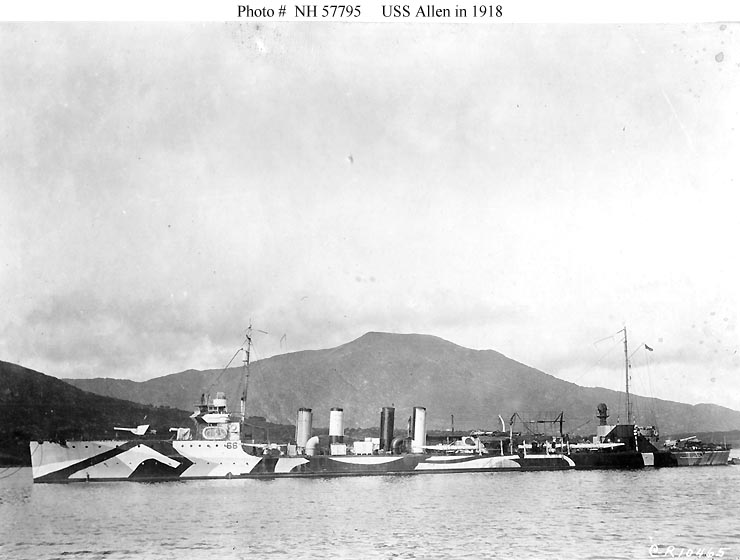
USS Allen Camouflaged in 1918. She was the only US destroyer to be laid down in 1915 and take part in both conflicts, with 28 years under the flag, although 12 years in reserve made just 16 years. This was far better than all her sisters, which barely served for ten years at best (with the interwar Rum patrol)? But this paled in comparison to Some Fletcher and Sumner/Gearing class which were in service through modernizations from 1942 for some until the late 1980s, so over 38+ years.
In the five months after commissioning, after sea trials and Carribean shakedown cruise, USS Allen joined the destroyer force, Atlantic Fleet for fleet exercizes and patrol, escorting convoys along new England and from 6 April prepared for war.
The night of 30 April to 1st May 1917 saw hers escorting the USS Connecticut when she collided with USS Duncan. On 14 June, she departed New York to escort one of the first troopship convoys to France. She then headed north and arrived in Queenstown, Ireland and started to escort convoys on their last leg in British waters. USS Allen commander was back then Henry D. Cooke. later awarded the Navy Cross. She accompanies convoys both to French and British ports and made in patrols ten U-Boat sightings (and attacks) but failed to male any kill.
On 14 July 1917 USS Allen escorted SS Rhesus and SS Idomeneus when the former signalled a torpedo wake, possibly from U-49 or U-58. She attacked but made not kill. By December 1918 she escorted the presidential liner SS George Washington to Brest in France. Back to Queenstown, she departed after Christmas for home, New York arriving on 7 January 1919.
After an overhaul she resume East Coast/West Indies fleet service, until 22 June 1922. She was decommissioned and placed in reserve but reactivated on 23 June 1925 to be a training platform for naval reservists, based in Washington, D.C. From March 1928, she returned to the Reserve, berthed at Philadelphia. She spent there the next 12 years and on 23 August 1940, unlike all her sisters, she was fully recommissioned at Philadelphia.
After a few modifications she resumed her early interwar service as training ship along the East Coast but was soon reassigned to the Pacific Fleet, entering DesDiv 80, and soon relocated at Pearl Harbor in Hawaii as tension grew with Japan. On 7 December 1941, she was moored in East Loch, northeast of Ford Island, southeast of the hospital ship USS Solace (AH-5). She claimed during the attack to have assisted downing three planes.
Right after she was needed for a escorting ships which brought troops to various islands of the Hawaiian chain, also patrolling for IJN submarines. However soon she was reconverted to be used as a “training foe”, work up new submarine crews trained in penetrating ASW defensive positions. Allen acting as the “red” or defender. In this role she trained a very considerable amount of future submarine captains (including aces) on the numerous Gato/Balao and Tench class boats that all went through this advanced training. But to break the monotony she also made training cruises periodically to the United States West Coast and back. Therefore she saw only “mock action” during her service, with Pearl Harbor as the only time she really met a real enemy. There was little else to do for such a “relic”, too slow and small (thrice lighter than a Gearing class !) to take on frontline duties, notably for the sake of standardization.
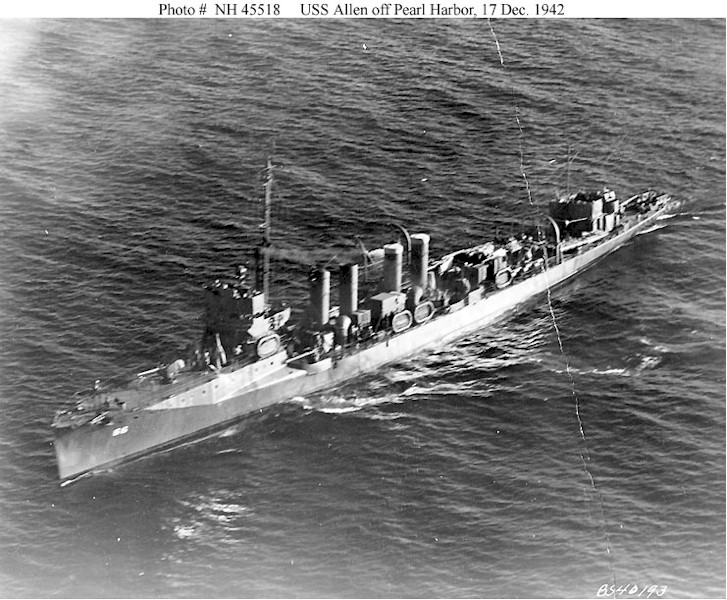
USS Allen in 1942
In September 1945, USS Allen left Hawaii to Philadelphia, to be at last decommissioned, on 15 October 1945. Stricken on 1 November 1945, she was sold to the Boston Metals Company in Baltimore and her scrapping commenced on 26 September 1946. She earned the title of USN destroyer’s granddady, as longest-serving destroyer in history so far (some WW2 Gearing/Sumner would beat her in the cold war at that, under new flags). She was also the most awarded destroyer of the serie, earning the WWI Victory Medal with “DESTROYER” clasp, the American Defense Service Medal with “FLEET” clasp, the Asiatic-Pacific Campaign Medal (one battle star) and the World War II Victory Medal.
 USS Wilkes DD-67
USS Wilkes DD-67
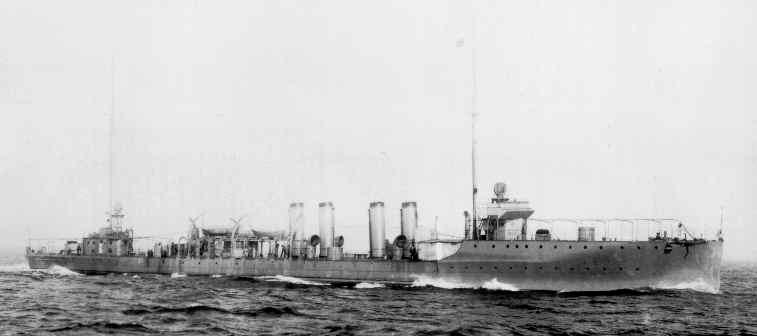
USS Wilkes was outfitting during the winter of 1916-17. She was in the Philadelphia Navy Yard and and after sea trials, in the Newport Torpedo Station before starting fleet maneuvers off Cuba. She was back on the east coast when Germany declared unrestricted submarine warfare for neutrrality patrols based in Norfolk, on 7 March 1917.
From April, she escorted French cruiser Amiral Aube from Norfolk to New York and on 15 June, departed to cover the first American troop convoy to Europe bound to Saint Nazaire, France, on the 26th. She headed Portsmouth, arriving for Independence Day and then joined the rest of the destroyer force at Queenstown (6 July).
He role alternated like the others between regukar escort work from mid-Atlantic to Europe, either in British of French ports (Brest and Saint Nazaire), and antisubmarine patrols. The winter of 1917-18 was the mùost gruelling in particular with long night hours in stormy seas making u-Boats sightings rare. She once rescued 23 from SS Purley on 25 July 1917. Christmas 1918 saw her eventually departing Queestwon bound for New York, arriving on 7 January 1919.
After an overhaul she departed in May to act as a picket ship for the first transatlantic flight, for four Navy-Curtiss (NC) flying boats. She was stationed between the Azores and Ponta Delgada on the 17-20 May 1919 and Lisbon, Portugal. She was there on the 27th, present for the celebration among all the 17 destroyer presents along the historical trip. She departed UK on 31 May for New York and reintegrate the destroyer force, Atlantic for 34 months, and in the winter fleet manoeuvers in the Caribbean and Gulf of Mexico, based from Newport, New York and Charleston. She was decommissioned on 5 June 1922 in Philadelphia Navy Yard.
By the summer of 1926 she was “loaned” to the Coast Guard to patrol during the Prohibition, based in New London and started operations from 23 August 1926 under command of Lt. Cdr M. J. Ryan of the USCG, and served in that role for eight years far more than her war time. She ceased activity on 15 March 1934, decommissioned on the 29th, returned to the Navy, stricken on 5 July, sold on 22 August.
 USS Shaw DD-68
USS Shaw DD-68
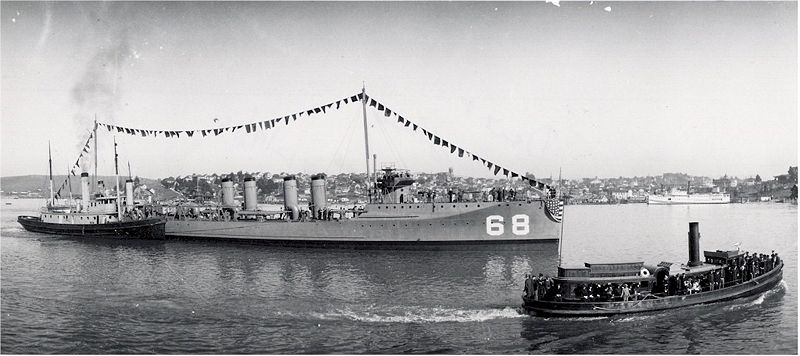
USS Shaw was commissioned on 9 April 1917, so just as the US entered war. After sea trials, she skipped the shakedown and sailed directly from Mare Island on 25 May to New York, being prepared in June for distant service. She sailed with the fourth Expeditionary Force convoy to France.
On 26 June after refuelling from a fleet tanker she arrived in Quiberon Bay, France on 1 July and on Independence Day, she sailed from St. Nazaire to Queenstown (now Cobh) in Ireland, starting patrol and convoy escort on 10 Julmy and until the end of the war without incident. However almlst a year later on 1st July 1918, she received an SOS from the transport Covington just torpedoes, and rushed to save survivors, finding the ship was under tow, but sank the next day. On 25 September she performed an attack on a sighted U-Boat but had no result.
On 9 October while escorting the giant liner SS Aquitania her rudder jammed as she performed a zigzag pattern, and headed straight for the liner, which struck her at her bow, slicing 90 feet (27 m) of it. Her bridge was mangled and she caught fire (12 sailors lost). Damage control was efficient so that she was saved but evacuated with just 21 men remaining and managing to have her across 40 miles into the nearest port under her own power.
Repaired at Portsmouth until 29 May 1919 she headed back to NyC (17 June) and was overhauled at Philadelphia Navy Yard (2 October) before joining the reserve, decommissioned on 21 June 1922.
On 25 March 1926 she was transferred to the Coast Guard and did her next years of service as part of the “Rum Patrol” until returned to the USN, recomm. on 30 June 1933, but stricken on 5 July 1934, sold for BU on 22 August.

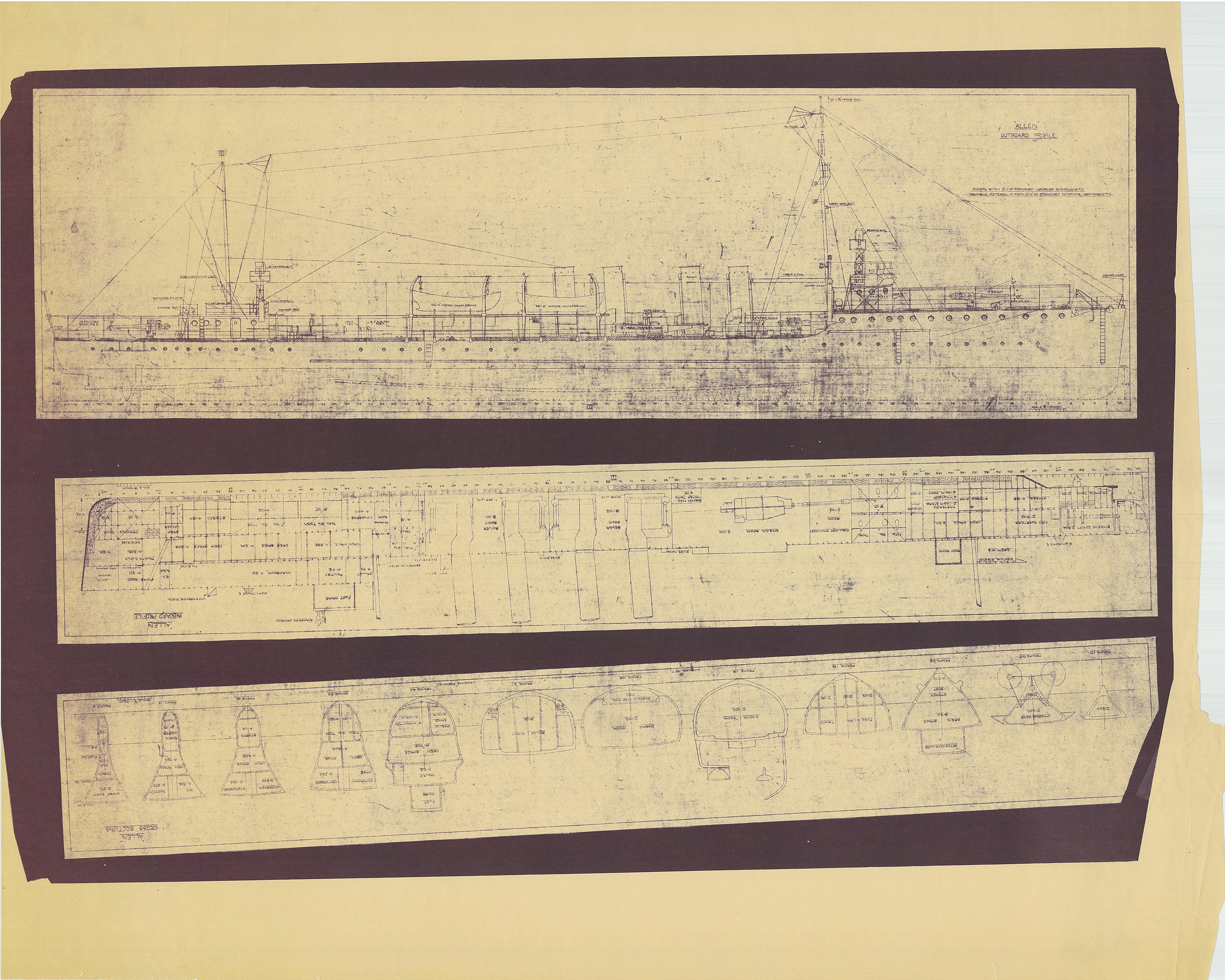
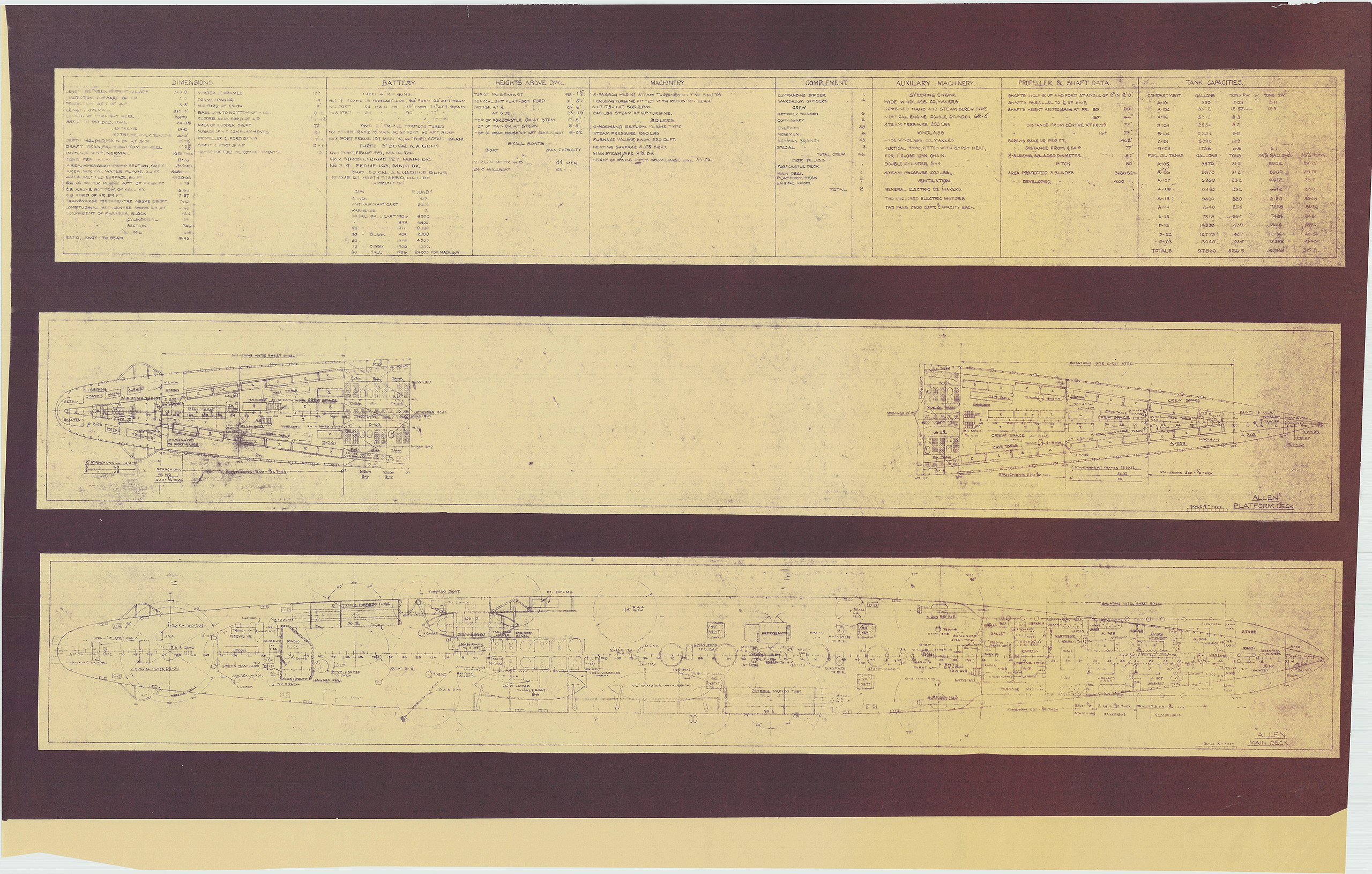
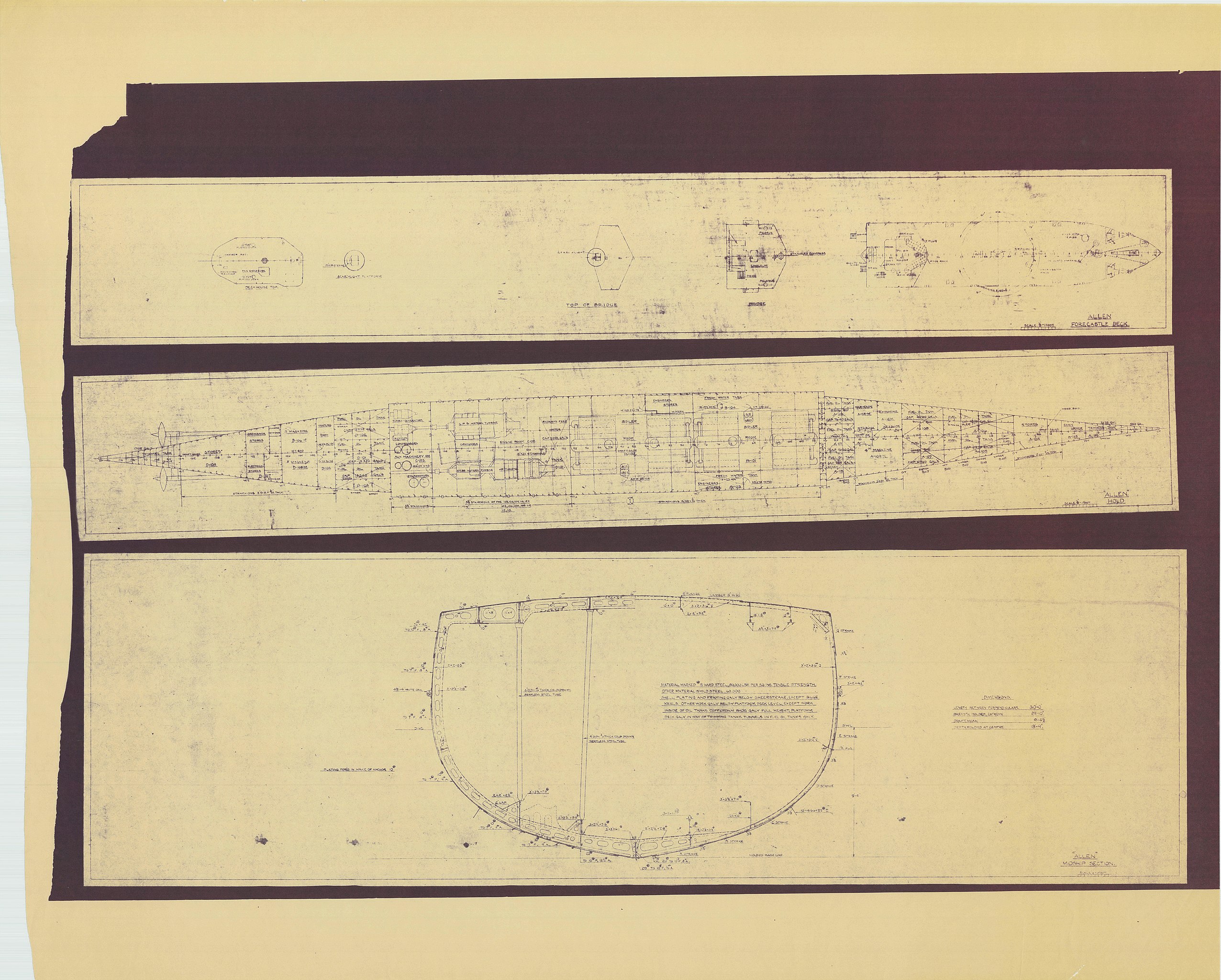
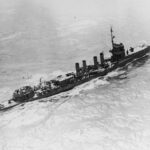
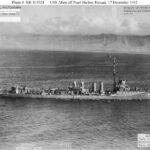
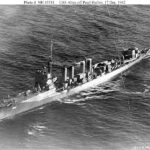
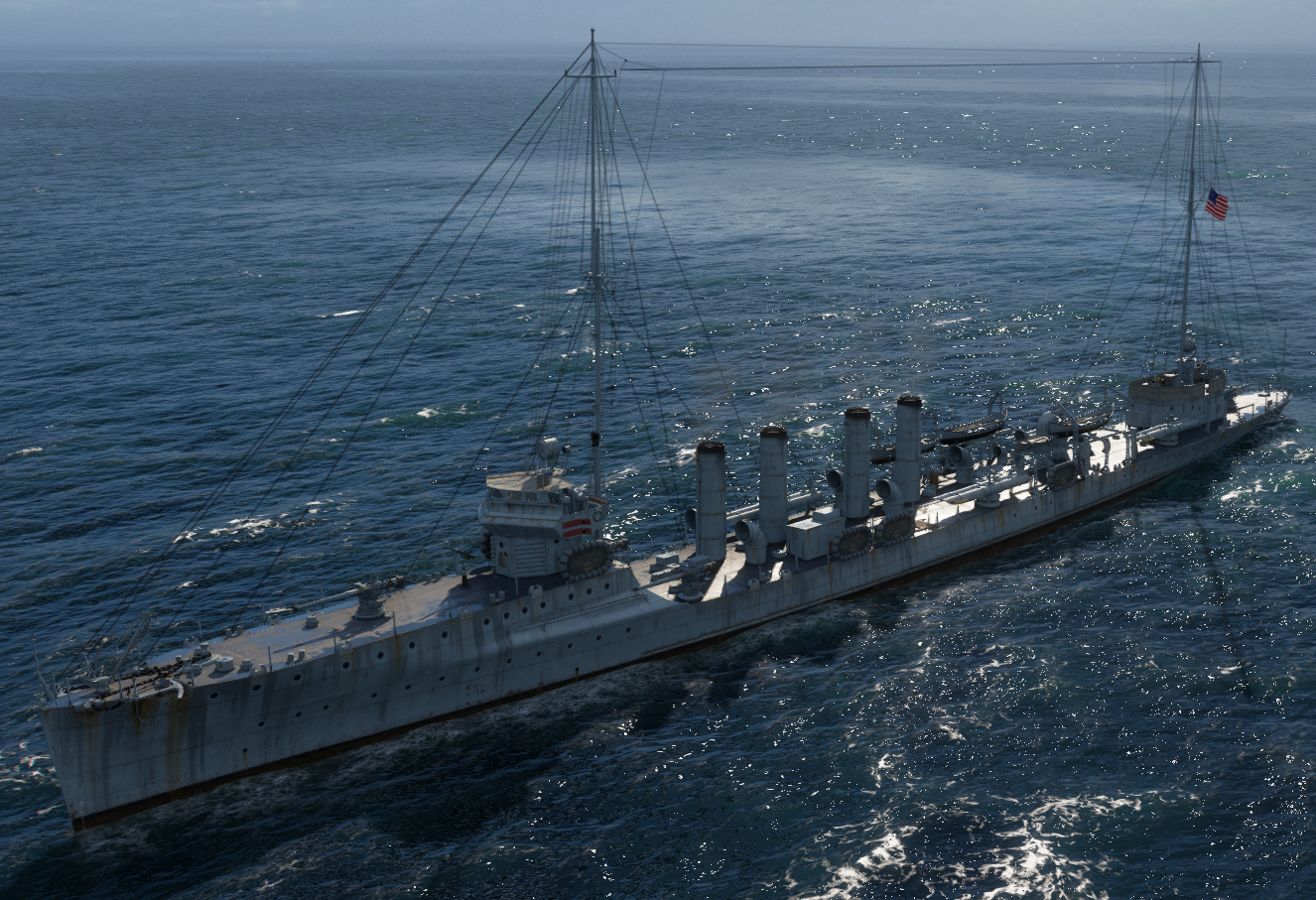
 Latest Facebook Entry -
Latest Facebook Entry -  X(Tweeter) Naval Encyclopedia's deck archive
X(Tweeter) Naval Encyclopedia's deck archive Instagram (@navalencyc)
Instagram (@navalencyc)





 French Navy
French Navy Royal Navy
Royal Navy Russian Navy
Russian Navy Armada Espanola
Armada Espanola Austrian Navy
Austrian Navy K.u.K. Kriegsmarine
K.u.K. Kriegsmarine Dansk Marine
Dansk Marine Nautiko Hellenon
Nautiko Hellenon Koninklije Marine 1870
Koninklije Marine 1870 Marinha do Brasil
Marinha do Brasil Osmanlı Donanması
Osmanlı Donanması Marina Do Peru
Marina Do Peru Marinha do Portugal
Marinha do Portugal Regia Marina 1870
Regia Marina 1870 Nihhon Kaigun 1870
Nihhon Kaigun 1870 Preußische Marine 1870
Preußische Marine 1870 Russkiy Flot 1870
Russkiy Flot 1870 Svenska marinen
Svenska marinen Søværnet
Søværnet Union Navy
Union Navy Confederate Navy
Confederate Navy Armada de Argentina
Armada de Argentina Imperial Chinese Navy
Imperial Chinese Navy Marinha do Portugal
Marinha do Portugal Mexico
Mexico Kaiserliche Marine
Kaiserliche Marine 1898 US Navy
1898 US Navy Sovietskiy Flot
Sovietskiy Flot Royal Canadian Navy
Royal Canadian Navy Royal Australian Navy
Royal Australian Navy RNZN Fleet
RNZN Fleet Chinese Navy 1937
Chinese Navy 1937 Kriegsmarine
Kriegsmarine Chilean Navy
Chilean Navy Danish Navy
Danish Navy Finnish Navy
Finnish Navy Hellenic Navy
Hellenic Navy Polish Navy
Polish Navy Romanian Navy
Romanian Navy Turkish Navy
Turkish Navy Royal Yugoslav Navy
Royal Yugoslav Navy Royal Thai Navy
Royal Thai Navy Minor Navies
Minor Navies Albania
Albania Austria
Austria Belgium
Belgium Columbia
Columbia Costa Rica
Costa Rica Cuba
Cuba Czechoslovakia
Czechoslovakia Dominican Republic
Dominican Republic Haiti
Haiti Hungary
Hungary Honduras
Honduras Estonia
Estonia Iceland
Iceland Eire
Eire Equador
Equador Iran
Iran Iraq
Iraq Latvia
Latvia Liberia
Liberia Lithuania
Lithuania Mandchukuo
Mandchukuo Morocco
Morocco Nicaragua
Nicaragua Persia
Persia San Salvador
San Salvador Sarawak
Sarawak Uruguay
Uruguay Venezuela
Venezuela Zanzibar
Zanzibar Warsaw Pact Navies
Warsaw Pact Navies Bulgaria
Bulgaria Hungary
Hungary

 Bundesmarine
Bundesmarine Dutch Navy
Dutch Navy Hellenic Navy
Hellenic Navy Marina Militare
Marina Militare Yugoslav Navy
Yugoslav Navy Chinese Navy
Chinese Navy Indian Navy
Indian Navy Indonesian Navy
Indonesian Navy JMSDF
JMSDF North Korean Navy
North Korean Navy Pakistani Navy
Pakistani Navy Philippines Navy
Philippines Navy ROKN
ROKN Rep. of Singapore Navy
Rep. of Singapore Navy Taiwanese Navy
Taiwanese Navy IDF Navy
IDF Navy Saudi Navy
Saudi Navy Royal New Zealand Navy
Royal New Zealand Navy Egyptian Navy
Egyptian Navy South African Navy
South African Navy






























 Ukrainian Navy
Ukrainian Navy dbodesign
dbodesign